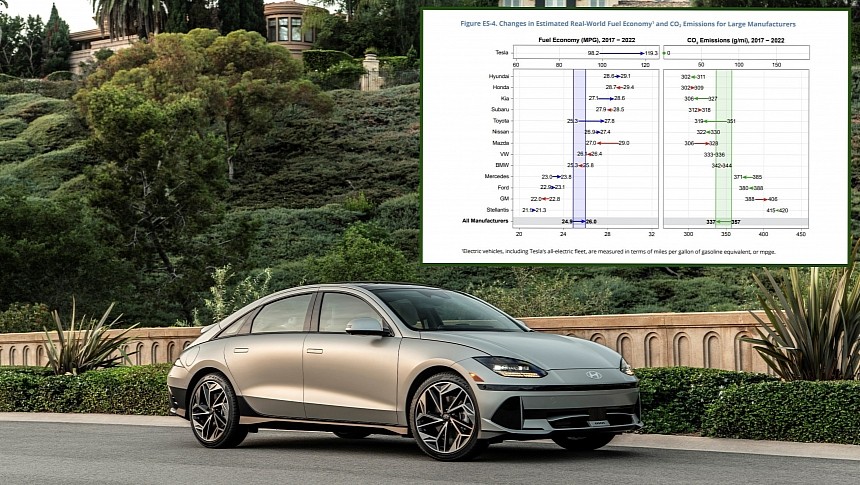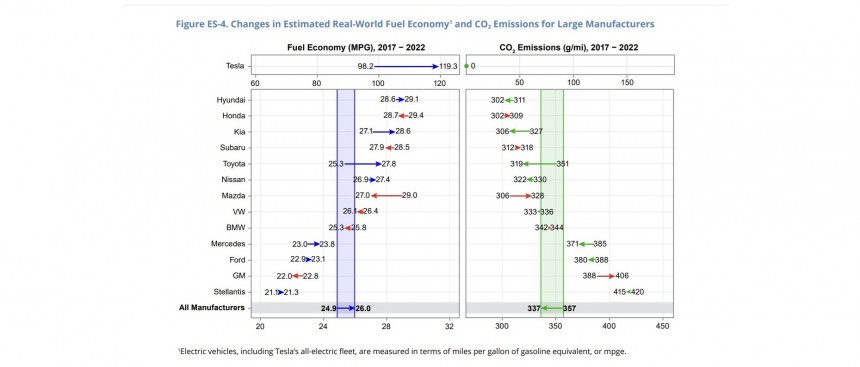Since 1975, the Environmental Protection Agency has issued the Automotive Trends Report on a yearly basis to provide the public with new light-duty vehicle fuel economy, greenhouse gas emissions, and technology data. The 2023 EPA Automotive Trends Report concerns 2017 to 2022 model year new light-duty vehicles, and the single most interesting piece of information in the report is Figure ES-4.
According to said figure, Tesla is the nation's fuel economy champion thanks to a real-world fuel economy of 119.3 miles per gallon equivalent and a fleet average of precisely zero grams of carbon dioxide emissions per mile. The question is, what else did you expect from an automaker that started with and continues to focus on EVs exclusively?
The fun part starts with the second-rated automaker, which – curiously enough – isn't Rivian. The curious part is that the EPA lists the R1T electric pickup truck and R1S electric sport utility vehicle as 2022 models on its website. Be that as it may, remember that there was no R1T and R1S prior to model year 2022. In any case, the independent agency established by Richard Nixon by executive order in 1970 has crowned Hyundai as the most fuel-efficient legacy automaker in the USA.
Hyundai improved from an estimated real-world fuel economy of 28.6 miles per gallon for the 2017 model year to 29.1 for 2022. If you prefer metric units, make that 8.2 liters per 100 kilometers and 8.1 liters per 100 kilometers. Honda is next, with the Japanese automaker downgrading from 29.4 miles per gallon (8.0 liters per 100 kilometers) in 2017 to 28.7 miles per gallon (8.2 liters per 100 kilometers) in 2022. i-VTEC and Earth Dreams what now?
Kia is fourth with 27.1 and 28.6 miles per gallon (8.7 and 8.2 liters per 100 kilometers), respectively, while Subaru ranks fifth. Considering that Subaru is all about boxer engines, which are oftentimes less efficient than inline- and V-type powerplants in similar applications, that is – hands down – surprising. By the way, did you know that the 2022 Subaru Ascent and 2022 Honda Pilot are both listed with combined fuel economy ratings of 23 and 22 miles per gallon (10.2 and 10.7 liters per 100 kilometers)?
The biggest improvement between 2017 and 2022, however, was recorded by the second best-selling automaker in the United States of America. The EPA says that Toyota improved from 25.3 to 27.8 mpg (9.3 to 8.5 l/100 km). Average carbon dioxide emissions improved from 352 grams per mile to 319 for model year 2022.
Mazda experienced the biggest reversal in terms of fuel economy and emissions, namely 29 to 27 miles per gallon (8.1 to 8.7 liters per 100 kilometers) and 306 to 326 grams of carbon dioxide per mile. Stellantis, which is another way of saying FCA + PSA = LOVE, is the worst-rated automaker by far. According to the attached report, Stellantis recorded 21.3 mpg (11.0 liters per 100 kilometers) and 415 grams for model year 2022.
The industry-wide average improved from 24.9 to 26.0 miles per gallon (9.4 to 9.0 liters per 100 kilometers), while carbon dioxide emissions went down 20 grams (from 357 in 2017 to 337 in 2022). If that seems a bit disappointing, bear in mind that legacy automakers in the United States of America are required to reach a fleet average of 59.4 miles per gallon (4.0 liters per 100 kilometers) for passenger cars and 42.4 (5.5) for light trucks in model year 2026.
That's a fleet-wide average of 49.1 miles per gallon (4.8 liters per 100 kilometers), which requires a fuel efficiency improvement of 8 percent on a yearly basis for model years 2024 through 2026. That said, now you know why Stellantis had to discontinue the 5.7-liter HEMI V8 from the Ram 1500 lineup in favor of a twin-turbo sixer.
The fun part starts with the second-rated automaker, which – curiously enough – isn't Rivian. The curious part is that the EPA lists the R1T electric pickup truck and R1S electric sport utility vehicle as 2022 models on its website. Be that as it may, remember that there was no R1T and R1S prior to model year 2022. In any case, the independent agency established by Richard Nixon by executive order in 1970 has crowned Hyundai as the most fuel-efficient legacy automaker in the USA.
Hyundai improved from an estimated real-world fuel economy of 28.6 miles per gallon for the 2017 model year to 29.1 for 2022. If you prefer metric units, make that 8.2 liters per 100 kilometers and 8.1 liters per 100 kilometers. Honda is next, with the Japanese automaker downgrading from 29.4 miles per gallon (8.0 liters per 100 kilometers) in 2017 to 28.7 miles per gallon (8.2 liters per 100 kilometers) in 2022. i-VTEC and Earth Dreams what now?
Kia is fourth with 27.1 and 28.6 miles per gallon (8.7 and 8.2 liters per 100 kilometers), respectively, while Subaru ranks fifth. Considering that Subaru is all about boxer engines, which are oftentimes less efficient than inline- and V-type powerplants in similar applications, that is – hands down – surprising. By the way, did you know that the 2022 Subaru Ascent and 2022 Honda Pilot are both listed with combined fuel economy ratings of 23 and 22 miles per gallon (10.2 and 10.7 liters per 100 kilometers)?
Mazda experienced the biggest reversal in terms of fuel economy and emissions, namely 29 to 27 miles per gallon (8.1 to 8.7 liters per 100 kilometers) and 306 to 326 grams of carbon dioxide per mile. Stellantis, which is another way of saying FCA + PSA = LOVE, is the worst-rated automaker by far. According to the attached report, Stellantis recorded 21.3 mpg (11.0 liters per 100 kilometers) and 415 grams for model year 2022.
The industry-wide average improved from 24.9 to 26.0 miles per gallon (9.4 to 9.0 liters per 100 kilometers), while carbon dioxide emissions went down 20 grams (from 357 in 2017 to 337 in 2022). If that seems a bit disappointing, bear in mind that legacy automakers in the United States of America are required to reach a fleet average of 59.4 miles per gallon (4.0 liters per 100 kilometers) for passenger cars and 42.4 (5.5) for light trucks in model year 2026.
That's a fleet-wide average of 49.1 miles per gallon (4.8 liters per 100 kilometers), which requires a fuel efficiency improvement of 8 percent on a yearly basis for model years 2024 through 2026. That said, now you know why Stellantis had to discontinue the 5.7-liter HEMI V8 from the Ram 1500 lineup in favor of a twin-turbo sixer.






















